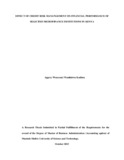| dc.description.abstract | Microfinance provides low-income individuals with a range of financial and non-financial services. They are essential in advancing Kenya's economic growth and financial inclusion. Interest on initial monies provided to small and medium-sized business owners accounts for the majority of their revenue. Credit risk is the likelihood that borrowers may default on their loans. Considering that a large portion of microloans' borrowers are small businesses and low-income individuals or The loss incurred by credit clients who refuse to pay their debts in full and on time is known as credit risk, and it represents a significant risk to microfinance. The majority of the money is earned via interest received. Microfinance institutions lend to people because they lack collateral and credit history. Their liquidity, profitability, and financial performance are impacted by the risk of not receiving their principal and interest returned. Microfinance's financial performance can be improved and loan default losses reduced with efficient credit risk management. Their ability to manage credit risk is critical to their success financially. Their financial performance can be improved and their exposure to credit risk reduced with effective credit risk management. Credit risk management makes an effort to calculate the likelihood that a lender won't obtain the principal and interest that is owed, which could result in a loss of revenue and higher collection expenses. A crucial factor in microfinance performance is credit risk management. The efficiency of credit management systems is a major factor in the performance of micro financial institutions in Kenya. While some academics have questioned this conclusion, most scholars concur that credit risk management affects financial success. The impact of credit risk management on the financial performance of microfinance institutions in Kenya is investigated in this study. The study specifically aimed to determine the impact of credit appraisals, credit risk management, credit terms, and credit approvals on Kenya's microfinance institutions' financial performance. Panel data analysis and a descriptive survey research design were employed in the study. The unit of analysis consisted of all 52 of the Association of Microfinance's registered microfinance institutions. Primary data was gathered using questionnaires, and secondary data was gathered by record survey sheets. Both descriptive and inferential statistics were used to analyze the data. The investigation found that sound Reducing bad debt, increasing cash flow and profitability, increasing net interest margin, and increasing return on capital invested are all greatly enhanced by effective credit risk management. The report suggests that in order to boost financial performance, Micro Finance Institutions in Kenya should invest in effective credit risk management. The report suggests that future research on Sacco's compare study findings, add a moderator for company size, and conduct research on MFIs that are not registered and are not members of the nation's Association of Microfinance Institutions. | en_US |

